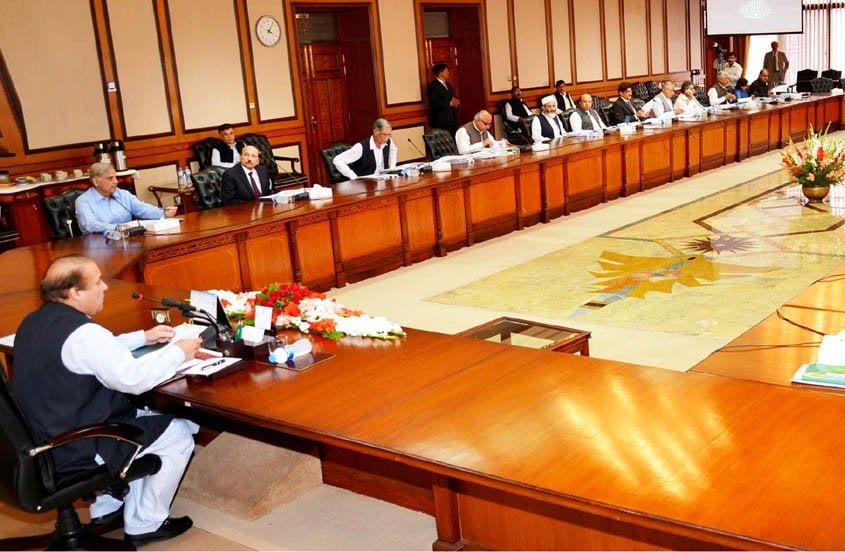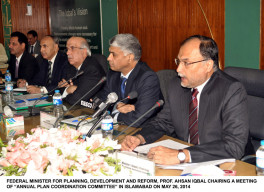
In a bid to drive economic growth and tackle energy shortages, the National Economic Council on Monday approved Rs1,514 billion development budget for fiscal year 2016, up by Rs326 billion or 27% from the revised spending level in the outgoing fiscal year.
Headed by Prime Minister Nawaz Sharif, with the four provincial chief ministers in attendance, the country’s highest economic decision-making body, approved Rs700 billion for the federal Public Sector Development Programme (PSDP) and another Rs814 billion for provincial development budgets. Of the total Rs1,514 billion, only about 15% will be financed by borrowing from international lenders.

In addition, the Water and Power Development Authority (Wapda), and the two biggest state-owned power companies – the Pakistan Electric Power Company (Pepco) and the National Transmission and Dispatch Company (NTDC) – will spend Rs175 billion from their own free cash flows, over and above the government’s development budget.
The federal PSDP for fiscal 2016 is Rs158 billion, or 29%, higher than the outgoing fiscal year’s revised development budget of Rs542 billion. The revised budget is Rs17 billion higher than the original allocation after the government transferred spending on Internally Displaced Persons (IDPs) into the development budget.
The Rs700 billion federal PSDP allocation for the new fiscal year includes Rs100 billion for enhancing security and reconstructing infrastructure in war-affected districts of the Federally Administrated Tribal Areas (FATA). The government was going to spend this money anyway, but decided to allocate it under the development budget to make overall development spending look bigger.

Provincial budgets
In order to accommodate the provinces, the federal government also conceded fiscal space to the federating units and agreed to finance health and population welfare projects, even though, constitutionally, those areas are the responsibility of provincial governments. Under its original proposal, Islamabad had decided to cut Rs14 billion funding to population welfare and healthcare projects, faced with pressure from the provinces, withdrew the proposal. The National Health Services Ministry will now receive Rs20 billion.
Spending and growth
In the outgoing fiscal year, the government spent Rs1,188 billion on development projects, Rs13 billion higher than the original Rs1,175 billion budget. Of that, Rs646 billion was spent by the provinces.
The proposed development budget is aimed at providing impetus to economic growth, which has remained muted in the first two years of the Nawaz Administration. Even Punjab Chief Minister Shahbaz Sharif, one of the two key leaders of the ruling PML-N, raised the issue of sluggish economic growth during the NEC meeting, said one official who attended the meeting. Shahbaz urged Islamabad not to restrain growth at the expense of stabilising the economy, said the official. Finance Minister Ishaq Dar responded by saying that he plans to unveil a pro-growth budget on June 5.
The NEC also approved a 5.5% economic growth rate target for fiscal 2016, with an inflation target at 6%.
New PSDP
The new PSDP comprises 938 projects worth Rs5.2 trillion. Of these, 273 projects are new and have an estimated value of Rs1.5 trillion. Out of the Rs700 billion allocated for 938 schemes, Rs246 billion has been allocated for transportation and communications infrastructure.
Social sector allocations are proposed at Rs70.4 billion. The Higher Education Commission will receive Rs20.5 billion which is Rs5 billion less than this year’s spending. For science and information technology, Rs7 billion has been allocated, and for governance improvement projects, Rs8.4 billion have been approved.
For the first time, the Prime Minister’s Youth Programme has been granted an allocation in the development budget: Rs20 billion. Discretionary development projects identified by parliamentarians have been allocated Rs20 billion as well.
Federal ministries will see their development allocations cut by 12%, from Rs303 billion in the outgoing year to Rs267 billion in fiscal 2016. Some of those changes are simply shifts in accounting entries. For instance, the Water and Power Ministry’s allocation has been cut from Rs46 billion to Rs31.9 billion. However, Wapda’s allocation for power projects has been increased to Rs72.8 billion in the new budget.
The Pakistan Atomic Energy Commission (PAEC) budget has also been reduced from Rs59.3 billion to Rs30.5 billion for the new fiscal year. In absolute terms, the PAEC budget was reduced by Rs28.7 billion or 48%.
The National Highway Authority will get the lion’s share in the new budget. The NHA will get Rs184 billion, up from Rs110 billion, mainly to complete the road projects for the China Pakistan Economic Corridor (CPEC).
The federal government has also earmarked Rs30 billion for ending disparities in development among the provinces.
A sum of Rs41 billion has also been given to Pakistan Railways aimed at building infrastructure to transport coal from Sindh to the rest of the country for coal-fired power projects.
Published in The Express Tribune, June 2nd, 2015.












































COMMENTS (1)
Comments are moderated and generally will be posted if they are on-topic and not abusive.
For more information, please see our Comments FAQ